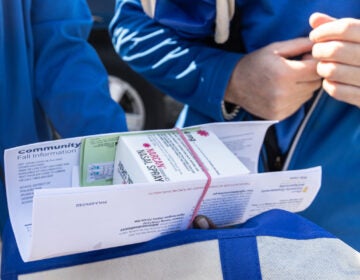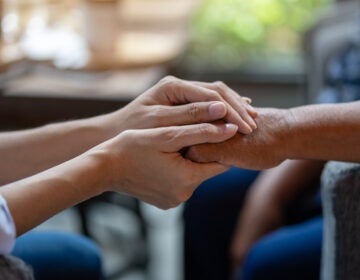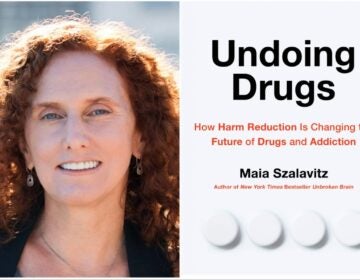At Kensington Storefront, those struggling with addiction get to tell their stories
Sharing personal narratives can help the storytellers see some of the good in their lives amid the trauma.
Listen 4:00
Kenan Nameli (left) and other workshop participants at the Kensington Storefront. Nameli lives in a nearby abandoned building, struggles with addiction, and said he has tried to enter into recovery a number of times. (Steve Weinik/Mural Arts)
On the first really hot afternoon this spring, people were out on Kensington Avenue, hollering to each other over the loud rumble of the train above and the scream of a passing siren. The Kensington Storefront is at the center of it all.
Last year, Philadelphia’s Department of Behavioral Health and Intellectual disAbility Services and Mural Arts program joined forces to open an art space there. Every day, visiting and local artists lead workshops for people who live in the neighborhood or on the street — most of them struggling with addiction. Classes range from weaving to jewelry making to theater programs. One workshop focuses on storytelling for people who have experienced trauma.
On that hot spring day, about a dozen people gathered in a small, well-lit room with low ceilings. Many of them wandered over from homeless encampments down the street — two of which have since been cleared of tents and mattresses crammed under the neighborhood’s low-passing bridges. Most were active users.
The workshop leaders described the day’s activity. Participants — most of them active users — would be making something called life maps: a visual representation of the people, places, and decisions that have made them who they are and defined what they care about.
Everyone settled in, and some started drawing. Others went outside for a cigarette and came back — some didn’t. Two storytellers from San Franciso’s Bay Area who make up the Million Person Project were leading the workshop. They were joined by internationally known street artist Caledonia Curry, who also goes by the name Swoon, and a therapist based in Washington state, Jess Radovich. The four were in Philadelphia as a part of a visiting residency, hosted by Mural Arts. They planned programing each day for two weeks, in some cases as guest facilitators of standing workshops. They were leading the life mapping exercise during a weekly class called “journaling for survivors,” taught by local artist Ashley Flynn, who herself is in recovery.
The workshop leaders spread out among the long folding tables and chatted with people as they worked on their life maps — or helped themselves to some of the huge tray of Spanish rice that Flynn had made for the group. After some time working on the maps, a woman named Monica volunteered to share hers. We agreed to use only her first name to protect her privacy.
Middle-aged and wearing a pink T-shirt that exposed burn marks on her arms, Monica sat at the front of the room with her life map and narrated what she’d drawn. Before she started, she offered a disclaimer, warning that she might mix up some words. She said that’s common for her after years of doing crystal meth.
“When I was young, my mother married my stepfather and he was part of a biker gang called the Hell’s Angels,” Monica began, pointing to a drawing of some flames in the top left corner of her map.
“I was always taught to be seen and not heard, so I can move around my house silently without anyone knowing. I had to creep down to the bathroom without anyone hearing because my stepfather would say, if he heard a [expletive] peep out of me, he would beat my ass.”
Monica went on to describe being abused by her stepfather and being molested by someone else. She told of harming herself, nodding at the burn marks. At times, she earned money on the street as a sex-worker, and she was raped. As she chronicled the difficult experiences she had endured, her testimony was also full of reflection.
“Everyone comes from someplace, so if they’ve harmed you — it helped me to realize that they came from someplace too,” she told the group.
When Monica had finished, her listeners thanked her for sharing. Some said they’d gone through similar struggles.
“I just want to get up and hug her,” one woman said. “I do, because I understand.”
Several women began speaking about the trials of sex work and the risk of assault, developing dialogues with one another.
Treating both substance abuse and trauma
Substance abuse and trauma often go hand-in-hand — somewhere around 20 percent of people in substance abuse treatment also have post-traumatic stress disorder, and that number is much higher for women. But it wasn’t until the 1990s that substance abuse and trauma started to be treated together.
Lisa Najavits, is a research psychologist at Boston University who studies treatment for people with both PTSD and addiction, has formed a treatment model called “Seeking Safety.” She said some of the thinking behind keeping treatment separate for so long was that trauma was primarily treated with past-focused models — exposure therapy that asked people to tell their trauma narrative.
But digging up painful memories before a person is stable or sober can be dangerous. It can cause them to use more, be triggered and retraumatized, harm themselves, and increase the risk of suicide. But because so many people (about two-thirds, according to her research) began using substances after a traumatic event, asking people to get sober before they begin treating their trauma was also unrealistic.
“How do they stop using a substance if they’re still feeling all that emotional pain from trauma?” said Najavits.
So, she developed an approach to treating substance abuse and trauma at the same time. It focuses on dealing with the present first by making sure someone feels safe, stable and secure before going into the back story — if at all. Her method and others have led the way in evidence-based practices for treating substance abuse and PTSD together over two decades.
Rehab programs and recovery groups such as Alcoholics Anonymous have used storytelling as a cornerstone of their process for years. But Najavits says clinicians need to be careful when asking someone to tell his or her personal narrative — especially in the case of a substance-use disorder. Najavits worries that a drop-in group setting led by artists, working with people who are actively using, doesn’t offer the safe space for people to tell their stories.
“If you have people go into their narrative of their life history — and you have no screening, no followup, no training, no awareness of the broader literature, I don’t care what you call it — that’s reckless,” she said.
Najavits said that working through trauma when people are high can be especially dangerous, and there are no rules about using before coming into the Kensington Storefront. The whole idea is that it is a judgment-free space.
The workshop leaders are the first to admit that they are operating as artists, not therapists. Even Radovich, the trained counselor, is just one person, unable to monitor the impact that the life-mapping exercise could have on all the participants who may be revisiting their trauma.
Connecting trauma, addiction yields new perspective
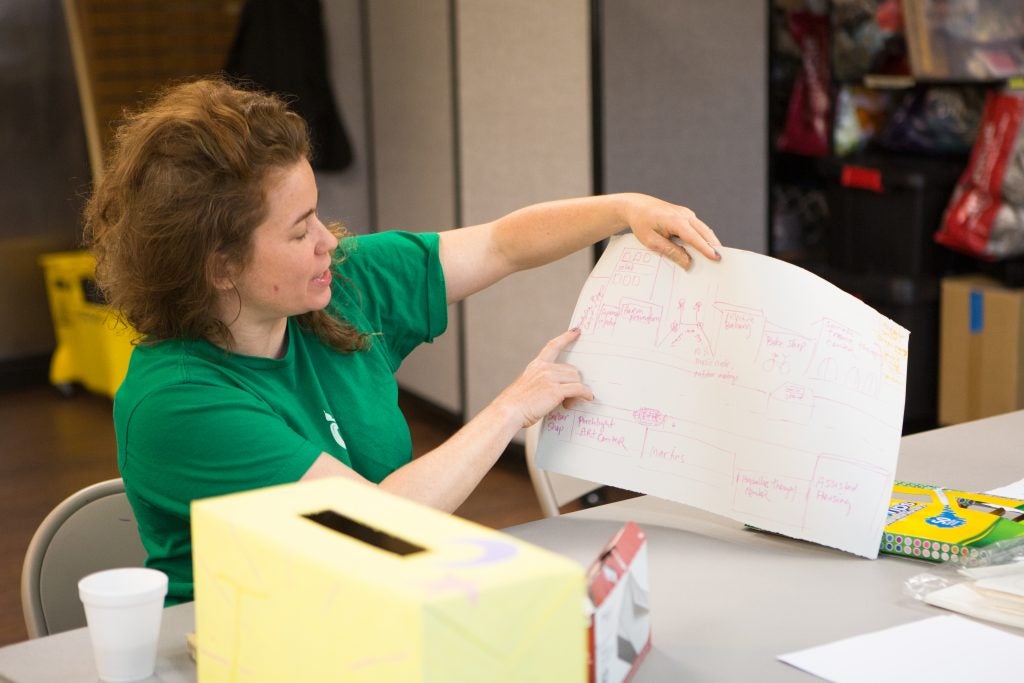
Caledonia Curry said she knows a project like this might not exactly follow clinical best practices, but the need in the community is great enough that she thinks doing something is better than nothing.
“When you look at the overall situation, it’s totally worth the risk of being imperfect in order to gain the chance to help and connect with people who are in such straits,” Curry said in a text message when asked about Najavits’ concerns to her. “I don’t consider the work dangerous, or I wouldn’t do it.”
Growing up, Curry’s parents were addicted to heroin, and, for a long time, she harbored a lot of resentment toward them. But, she said, learning about the connection between trauma and addiction changed that for her.
“For me, as somebody who grew up not understanding her own family, not being able to have compassion for my own mother, when I learned about the way that addiction works and how injured my mom was, I gained a level of compassion for her,” Curry explained.
She said telling others about that discovery was even more liberating.
“I was like, ‘I need to share this.’ Like, if I didn’t understand this, how many other people are out there who don’t understand this?”
That’s why, despite her background in visual art, Curry wanted to work in part on storytelling during her time in Kensington.
Curry said she and her team are conscious of the risks that come with digging into traumatic stories. But she thinks life mapping can actually help people see some of the good in their stories, instead of always focusing on the bad, which is easy to do in the cycle of addiction and homelessness.
Recognizing some of the good
During the life-mapping exercise, Curry worked with a woman named Jessica, whose last name WHYY agreed to withhold for her privacy. Jessica shared with Curry a list of harrowing events she had endured — the loss of her husband, relapse, homelessness, rape. But as they talked, Curry was able to encourage Jessica to touch some of her positive experiences, too. Jessica described rescuing her gator mouth pitbull, Champ, off the street, and nursing him into good health. She reminisced about what it was like when she got her whole family together around the holidays.
“My mom always hated my old man, and it was the one and only time that everyone was together,” she remembered. “All the dogs, the cats — it feels good — belonging to a family.”
Curry said storytelling came naturally for the workshop participants.
“I found that folks in the space start telling their life stories right away, even when it’s not a story exercise,” she said. “Our work was to connect them with some of the unseen strengths inside their difficult stories.”
Najavits cautioned that just because someone is inclined to launch into a personal narrative doesn’t mean it’s a good idea.
“There’s often this very naive sense, it’s called the catharsis model, where people believe if you can just tell your story, just spill it, get it out there, get it to light, you will relieve yourself of that intense painful narrative and the symptoms will dissipate or get better,” she said.
Najavits acknowledged that a program like this could be a great fit for some. But, she said, without screening for who is coming in, there is no way to know if you might be setting someone up to be triggered.
Gaps waiting to be filled
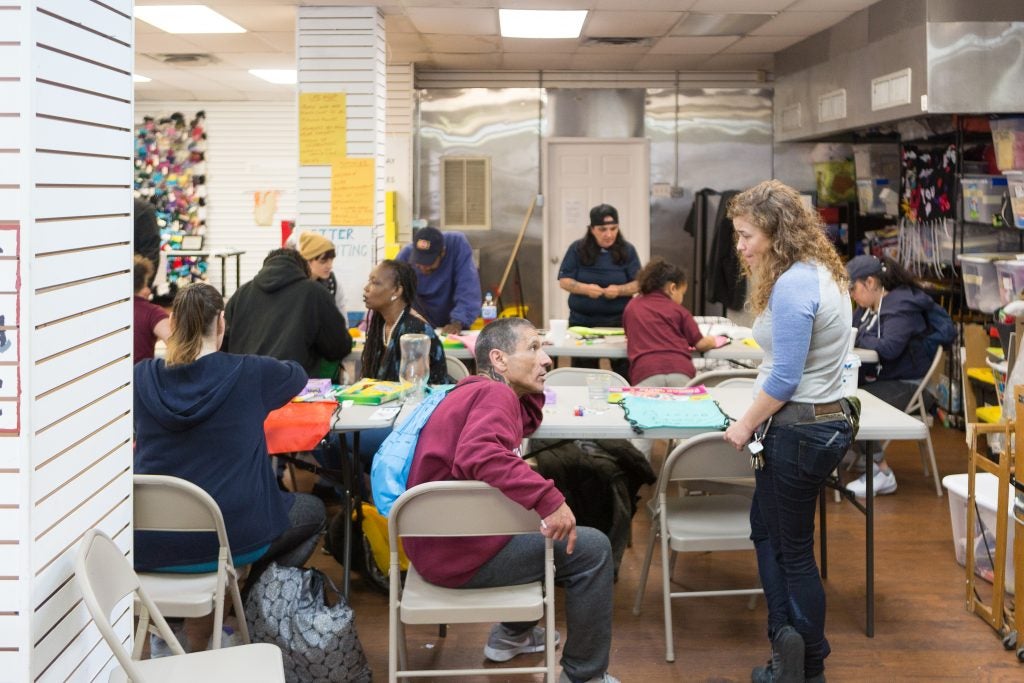
Not all of the work these artists were doing focused on storytelling. And the storefront hosts a variety of workshops — weaving classes and music and theater performances. Jane Golden, Mural Arts director, said she prides herself on the unique role that art can play in approaching social issues.
“I do think, when it comes to intractable problems, we cannot discount the role of innovation and creativity to make a difference,” she said. “Because our traditional interventions are going to fail us.”
Grass-roots efforts led by those with good intentions — but little or no clinical background — have become more common as the opioid epidemic has worsened. It’s a byproduct of a crisis society has failed to resolve, and that’s left gaps to fill. Depending on their scope — whether it’s mural making or storytelling for those with trauma — some of those creative endeavors have higher stakes than others.
Artists at the Kensington Storefront, including Curry, said those gaps are all the more reason to help and they’re doing their part to help in the face of a national emergency.
Kenan Nameli and some other workshop participants said they appreciate the space, if nothing else, for a cup of coffee and a reason to get off the street for a few hours. Nameli lives in an abandoned building nearby.
“I’ve never been able to sit still, right? This place has taught me how to collect myself, right? Really, it has,” said Nameli.
He pointed to a beaded bracelet on his wrist.
“This is what I made — little red skulls and a little stone,” he said. “I made that and that, and it made me feel so much better about myself for the day.”
For Curry, that’s the goal: to make someone’s day just a little better.
“They can be doing something and be told, you’re doing a great job. You’re beautiful, you’re awesome. Like, that does not happen for folks out there.”
WHYY is your source for fact-based, in-depth journalism and information. As a nonprofit organization, we rely on financial support from readers like you. Please give today.


